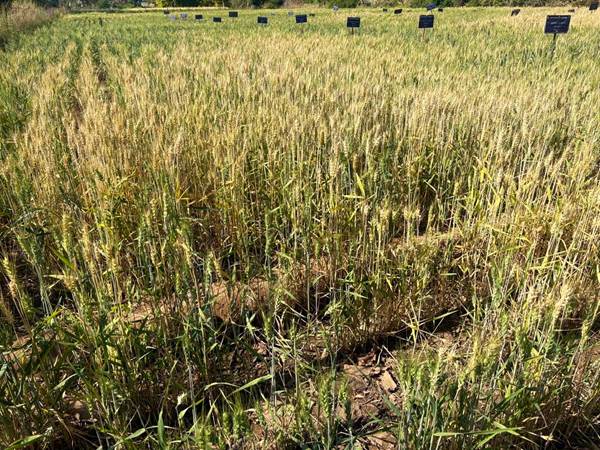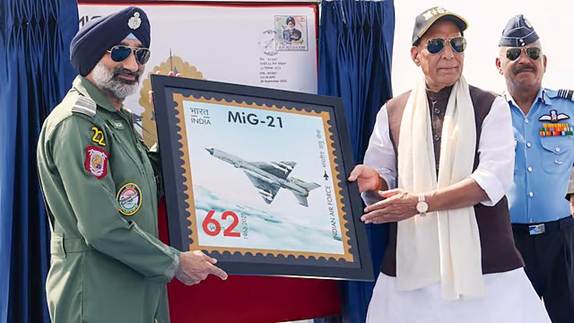Published on Sep 27, 2025
Daily Current Affairs
Current Affairs 27 September 2025

Content
- Trump slaps tariffs on drugs, trucks, furniture
- New farming technology holds potential to stop desertification
- Giving warriors a fighting chance
- MiG-21 jets fly into history after 6 decades of service
- Govt. survey on R&D in India gets weak response from private sector
- The India-EU Strategic Agenda
Trump slaps tariffs on drugs, trucks, furniture
What Happened ?
- Event: U.S. President Donald Trump announced new tariffs on imported goods on September 25.
- Details of Tariffs:
- 100% tariff on branded and patented pharmaceutical products.
- 25% tariff on heavy-duty trucks.
- 50% tariff on kitchen cabinets and bathroom vanities.
- 30% tariff on upholstered furniture.
- Effective Date: October 1.
Relevance :
- GS II (IR): India-U.S. trade relations, protectionism, Section 232 investigations.
- GS III (Economy): Impact on Indian pharmaceutical exports, generics vs branded drugs, global supply chains, Make in India implications.

Stated Reason
- Trump cited “large-scale flooding” of imported goods into the U.S. from foreign countries.
- Part of a broader protectionist trade policy, emphasizing U.S. manufacturing and domestic investment.
Legal & Policy Context
- The tariffs are aimed at better-established legal authorities after risks associated with previous global tariffs under Supreme Court scrutiny.
- Exemptions proposed: Companies already investing in U.S. manufacturing plants.
- Investigations under Section 232 (national security) ongoing, primarily focused on metals; generics appear largely exempt.
Indian Pharmaceutical Exports
- India’s Global Position:
- Largest supplier of generic drugs globally, covering ~40% of global generics demand.
- Supplies to the U.S. account for ~20% of Indian pharma exports, valued at approximately $5.7 billion in FY2024-25.
- Export Composition:
- Generics: ~80–85% of exports to the U.S.
- Branded / Patented Drugs: ~15–20% (smaller segment, mostly by multinational subsidiaries).
- Impact Assessment:
- The 100% tariff on branded drugs will not significantly affect Indian generics exports.
- Companies like Sun Pharma, Dr. Reddy’s, Cipla have U.S.-based manufacturing or re-packaging units, making them largely exempt from tariffs.
- Risk Mitigation: Indian industry advised to monitor policy shifts and Section 232 investigations.
Indian Trade & Economic Linkages
- Bilateral Trade (FY2024-25):
- India-U.S. total trade: ~$161 billion
- Pharmaceutical exports: ~$10–11 billion
- India is a net exporter of pharma to the U.S.
- Indirect Advantage:
- Higher U.S. tariffs on branded drugs could shift demand to Indian generics, benefiting mid-sized and small pharma exporters in the short term.
Strategic Implications for India
- Trade Diversification:
- Encourages Indian pharma to invest in U.S.-based manufacturing to bypass tariffs.
- Reinforces Make in India for exports, enhancing global supply chain reliability.
- Policy Awareness:
- Need for exporters to monitor Section 301 / Section 232 investigations and U.S. tariff notifications.
- Opportunity:
- U.S. tariffs could increase competitiveness of Indian generics, particularly in hospital and retail markets.
New farming technology holds potential to stop desertification
What’s Happening ?
- Innovation: Desert ‘soilification’ technology using an indigenous bioformulation.
- Objective: Convert arid desert sand into agriculturally productive soil, combating desertification in western Rajasthan.
- Location: Banseli village, Ajmer district, Rajasthan (edge of Thar desert).
- Timeline: Seeds sown in November 2024, harvested April 2025.
- Crop: Wheat variety Wheat-4079, indigenous.
- Yield Outcome:
- 13 kg seeds → 260 kg wheat per 1,000 sq. metres (ratio 1:20).
- Higher than normal wheat agriculture.
- Irrigation Efficiency: Only 3 cycles required instead of 5–6 in conventional wheat farming, showing high water retention.
Relevance :
- GS III (Environment & Agriculture): Desertification, soil degradation, water-efficient biotech farming, dryland crop diversification.
- GS II (Governance): Role of CUoR, KVK, Rajasthan Horticulture Dept; policy relevance for Desert Development Programme.

Why It’s in the News ?
- Environmental significance: Technology could stop the expansion of Thar desert towards the National Capital Region (NCR).
- Societal impact: Demonstrates applied science turning into productive agriculture in hostile conditions.
- Policy relevance: Supports sustainable agriculture, desert management, and water conservation, linked to GS III topics like Environment, Agriculture, and Disaster Management.
Scientific Background
- Technology:
- Sand transformed into soil-like structure using polymers and bioformulations.
- Promotes cross-linking of sand particles and stimulates beneficial microbes.
- Enhances stress resistance of crops in arid conditions.
- Laboratory Trials:
- Crops tested: Bajra, guar gum, chickpea.
- Result: 54% higher yield in bioformulation-amended sand.
- Field Trials:
- Pilot wheat crop on 1,000 sq. metres of desert land.
- Success demonstrates scalability in real desert conditions.
Institutional Support
- Lead Institution: Central University of Rajasthan (CUoR), Department of Microbiology.
- Collaborators:
- Krishi Vigyan Kendra (KVK): Layout planning and scaling of field trials.
- Rajasthan Horticulture Department: Field facilitation.
- Research Team: Led by Prof. Akhil Agrawal, executed by research scholar Diksha Kumari.
Future Plans
- Crop Expansion: Plan to grow millet, green gram, and other dryland crops.
- Geographic Expansion: Extend technology across Rajasthan and other arid regions of India.
- Sustainability: Reduce water dependency in agriculture, address desertification and soil degradation.
Broader Context
- Environmental Concern:
- Desertification in western Rajasthan, worsened by:
- Degradation of Aravali ranges.
- Unscientific plantation drives.
- Changes in rainfall patterns and sand dune spread.
- Desertification in western Rajasthan, worsened by:
- Agricultural Significance:
- Provides a solution to low productivity in arid lands.
- Demonstrates integration of biotechnology and sustainable farming.
- Global Relevance: Could be a model for desert agriculture in other arid regions worldwide.
Strategic Implications
- Climate Adaptation: Shows potential for water-efficient farming under extreme climatic conditions.
- Technology Transfer: Can inform government schemes like Desert Development Programme and watershed management initiatives.
- Socioeconomic Impact: Promotes livelihood security in marginal lands, improves local food production, and may reduce migration from desert areas.
Giving warriors a fighting chance
What’s Happening ?
- Establishment: NCDE was set up in 2020 at the CRPF Group Centre, Hakimpet, Hyderabad.
- Purpose: Exclusive facility for CAPF personnel who become physically disabled in the line of duty.
- Achievements in 5 years:
- Trained 219 Divyang warriors (physically challenged personnel).
- Produced medal-winning para-athletes and skilled IT professionals.
- Target Group: Personnel injured in Left Wing Extremism (LWE) operations, counter-terrorism, insurgency, accidents, or road incidents during service.
Relevance :
- GS III (Security): CAPF personnel welfare, rehabilitation, operational readiness.
- GS II (Governance): Skill development, inclusive policies for Divyang personnel, government schemes integration.
Why It’s in the News ?
- Focus on rehabilitation: Highlights India’s efforts to integrate disabled CAPF personnel into productive roles rather than mere financial compensation.
- Human-interest angle: Stories of trauma, resilience, and medal-winning achievements bring attention to the physical and psychological challenges faced by personnel.
- Policy relevance: Demonstrates government initiatives for welfare, skill development, and sports promotion for Divyang personnel, relevant for GS III topics: Security, Defence, and Welfare Programs.
Background
- LWE operations:
- 38 districts affected in India; 15 in Chhattisgarh (2024).
- Operations reduced LWE districts from 126 (2013) to 18 (April 2025).
- Risk to personnel:
- Frequent IED explosions and ambushes.
- Since 2016, 46 CRPF personnel lost limbs in LWE operations.
- 2023: 10 personnel underwent amputations.
- Government directive: Injured personnel allowed to continue service until retirement with full benefits, supported with best medical care and prosthetics.
NCDE Facilities & Rehabilitation Approach
- Campus:
- 180 barracks, 100+ wheelchair-friendly.
- Equipped with ramps, elevators, motorised buggies, and hospital for emergencies.
- Physical rehabilitation:
- Gym with specialized machines, physiotherapy rooms, gait training, and strength building.
- Artificial limbs: 106 fitted, 135 pending (as of July 2025).
- Mental health support:
- Counselling for PTSD, trauma care, and phantom limb syndrome.
- Meditation and mindfulness sessions.
- Skill & Career support:
- Sports training: Archery, discus, shot put, national/international competitions.
- IT training in collaboration with BITS Pilani.
- Desk/clerical jobs for personnel choosing non-sports paths.
Policy & Institutional Significance
- Single-window system: Consolidates rehabilitation, medical care, prosthetics, counselling, and career planning.
- Government support:
- Financial: CAPF welfare fund, Bharat Ke Veer donations, CGHS coverage for prosthetics.
- Employment: Retention in service, reassignment, and sports promotion.
- Strategic importance:
- Enhances morale and operational readiness.
- Reduces psychological burden of injury among serving personnel.
Strategic Implications
- Resilience & adaptation: Personnel demonstrate extraordinary willpower and adaptability—translating combat endurance into sports and professional excellence.
- Best practices for other forces: NCDE model can be replicated across CAPFs and armed forces for comprehensive injury rehabilitation.
- Policy integration: Highlights need for continuous welfare, mental health support, and skill development for personnel with service-related disabilities.
MiG-21 jets fly into history after 6 decades of service
What’s Happening ?
- Event: Indian Air Force (IAF) formally retired its last MiG-21 fighter jets on September 26, 2025, at Chandigarh Air Force Station.
- Squadrons retired:
- No. 23 Panthers
- No. 3 Cobras
- Together operated 36 aircraft.
- Significance: MiG-21 served the IAF for over six decades (1963–2025) and participated in major conflicts and operations.
Relevance :
- GS III (Defence & Security): Fleet modernization, indigenous aircraft programs (LCA-Tejas, AMCA), operational capability.
- GS II (IR / Strategic Affairs): India-Russia defence cooperation, regional security implications (China, Pakistan).

Why It’s in the News ?
- Historical moment: Marks the end of an era for India’s first-generation supersonic fighter fleet.
- Operational implications: IAF’s fighter squadron strength reduces to 29, below the sanctioned strength of 42, highlighting a gap in operational readiness.
- Emotional and symbolic: Ceremony attended by Defence Minister, IAF chiefs, veterans; includes aerial displays by Tejas, Jaguar, and Surya Kiran team.
Historical Significance of MiG-21
- Induction: 1963, frontline interceptor and multi-role fighter.
- Key Conflicts / Operations:
- 1971 Indo-Pak war
- Kargil conflict
- Balakot air strikes
- Operation Sindoor
- Attributes: Single-engine, single-seater, versatile, low-maintenance, and symbol of Indo-Russian defence collaboration.
- Upgrades over time: MiG-21 Bison and other variants sustained relevance until retirement.
India-Russia Strategic Context
- MiG-21 legacy: Not just a fighter jet, but also a marker of India-Russia defence ties.
- Technology transfer: MiG-21 program enabled Indian engineers and pilots to gain expertise in fighter operations, maintenance, and upgrades.
- Strategic cooperation: Retirement highlights the transition from Soviet-era platforms to indigenous Indian aircraft (LCA-Tejas, AMCA).
Current Operational Status
- Squadron strength: 29, lowest since the 1960s.
- Fleet gap: Retirement of MiG-21 reduces interceptor capability and frontline fighter coverage.
- Replacement plans:
- LCA-Tejas operational in several squadrons; additional orders signed.
- Advanced Medium Combat Aircraft (AMCA) in development.
- Emphasis on indigenization and modern multirole fighters.
Lessons and Strategic Implications
- Legacy of MiG-21:
- Operational resilience and adaptability.
- Foundation for training, doctrine, and indigenous aircraft development.
- Current challenge: Fighter fleet is below sanctioned strength, stressing the need for fast induction of Tejas and other modern jets.
- Future focus:
- Strengthen indigenous aircraft programs (LCA-Tejas, AMCA).
- Maintain operational readiness during fleet transition.
- Enhance multi-role capabilities to replace aging Soviet-era aircraft.
Broader Defence Context
- Modernization: Retirement underscores urgent fleet modernization in light of regional threats (China, Pakistan).
- Indigenization: Signals shift from dependency on Russian imports to domestic fighter programs.
- Capability gap: Reduction to 29 squadrons highlights need for strategic procurement, training, and force planning.
Govt. survey on R&D in India gets weak response from private sector
What’s Happening ?
- The Science and Technology Ministry conducts a biennial National Science and Technology Survey to assess the state of scientific research in India.
- The latest edition (launched December 2024) surveys ~8,000 R&D bodies (public & private).
- Purpose: Measure domestic R&D expenditure, GDP share, number of scientists, patents, and overall global standing.
- Issue: Publication of results is being postponed due to weak response from private sector R&D firms.
Relevance :
- GS III (Science & Technology): R&D expenditure, innovation ecosystem, patents, STEM workforce.
- GS II / III (Governance & Policy): Public-private participation, policy planning, global competitiveness.
Why It’s in the News ?
- Government & industry gap: While 73% of government R&D institutions responded, only 35% of Indian industry bodies and 9% of multinational companies submitted data by September 2025.
- Impact: Delays the release of critical data that informs policy-making, planning, and benchmarking India’s scientific capacity.
- Event Highlight: FICCI workshop held to encourage private sector participation.
Survey Methodology
- Data collected via detailed questionnaires sent to institutions.
- Identities of firms are masked, but data provide trends for:
- Domestic R&D expenditure
- R&D’s share of GDP
- Scientist demographics, including gender ratio
- Patents and innovation output
- Comparative position of India globally
Key Findings ?
- Government contribution dominates: ~75% of India’s R&D spending comes from public sector.
- Private sector contribution is limited, unlike advanced economies where private firms dominate R&D funding.
- Challenges cited by industry:
- Unclear definition of “R&D spending” in questionnaires.
- Comparison with advanced economies deemed premature given India’s GDP per capita.
- Administrative burden in filling detailed survey data.
Policy Implications
- Need for private sector engagement: India’s R&D ecosystem is heavily public-funded, limiting innovation, global competitiveness, and industrial growth.
- Data-driven policy: Survey results inform policies on:
- Funding allocation
- Incentives for private R&D
- STEM workforce planning
- Patent & IP ecosystem strengthening
- International benchmarking: Weak private participation may skew India’s comparative R&D ranking globally.
Contextual Analysis
- Global comparison:
- Advanced economies rely on private R&D (60–70% of total), e.g., US, Germany, Japan.
- India relies 75% public funding, indicating need for industrial innovation push.
- Economic relevance: Strong private R&D is essential for technology-intensive industries, startups, and exports.
- Government initiatives:
- Workshops with FICCI to mobilize private sector participation.
- Likely extension of deadline to Nov 30, 2025, to increase submissions.
Challenges
- Data clarity: Ambiguity in defining R&D spending metrics.
- Compliance burden: Lengthy forms and reporting requirements.
- Perception gap: Private sector feels India’s R&D spending is already significant relative to GDP; reluctant to report.
- Global benchmarking pressure: Concerns that India may be unfairly compared with industrially advanced nations.
Way Forward
- Simplify reporting: Provide clearer guidelines and definitions for R&D expenditure.
- Incentivize participation: Link data submission to policy benefits or recognition.
- Enhance public-private partnerships (PPP): Encourage co-investment, joint research, and innovation clusters.
- Benchmarking & transparency: Use data for targeted policy interventions to strengthen India’s R&D ecosystem and global competitiveness.
The India-EU Strategic Agenda
Background and Context
- Timing: Ahead of the India-EU leaders’ summit scheduled for February next year, weekly preparatory meetings are planned.
- Reason: With the US under Trump showing unpredictability in global alliances, the EU positions itself as a predictable, all-weather partner for India.
- Official Document: EU issued a Strategic Agenda for India-EU ties based on five pillars:
- Economy & Trade
- Emerging Technologies
- Security & Defence
- Global Connectivity
- People-to-People Ties
Relevance :
- GS II (IR): Strategic partnership, FTA, investment protection, migration, people-to-people ties.
- GS III (Economy & Tech): Trade flows, technology transfer, industrial competitiveness, supply chain resilience.
- GS II/III (Security): Indo-Pacific security, maritime & cyber cooperation, counterterrorism.
Economy & Trade
- EU as a Partner:
- EU is India’s largest trading partner; India is the EU’s largest partner in the Global South.
- 2024 trade: Goods €124 billion, Services €90+ billion. EU exports €80 billion services to India.
- Investment & Employment:
- 6,000 European companies in India employ 3 million directly, millions indirectly.
- FDI: EUR 140 billion (2023), doubling in 5 years.
- Trade Imbalances:
- India accounts for <2.2% of EU trade in goods/services.
- Indian investment in EU: EUR 10 billion.
- Agreements in Progress:
- Free Trade Agreement (FTA): To reduce tariff & non-tariff barriers, target completion by end 2025.
- Investment Protection Agreement (IPA), Geographical Indications agreement, Comprehensive Air Transport Agreement, Macroeconomic & financial dialogue.
Global Connectivity
- EU Global Gateway: Mobilises EUR 300 billion for energy, digital, and transport infrastructure globally.
- India Initiatives: MAHASAKTI and MHASG (Security & Growth).
- Goal: Strengthen physical and digital connectivity between EU and India, opening new commercial opportunities for businesses.
Emerging Technologies
- EU Strengths: World-class research, digital infrastructure, regulation, green & digital tech expertise.
- India Strengths: Skilled workforce, large datasets, vibrant digital economy, strong startup ecosystem.
- Objective: Joint development and tech transfer, fostering innovation and industrial competitiveness.
Security & Defence
- Strategic Dialogue: Launched in June 2022, addressing maritime security, cyber security, counterterrorism, non-proliferation.
- Agreements in Negotiation:
- EU-India Security & Defence Partnership Agreement
- Security of Information Agreement for classified info sharing
- Cooperation Areas:
- Counterterrorism, terror financing, online propaganda, drug trafficking
- Dual-use technology, supply chain security, innovation
- EU-India naval cooperation in the Western Indian Ocean
- Strategic Alignment: EU’s Indo-Pacific security agenda aligns with India as a regional stability pillar.
- Economic Security Link: Stronger customs and technological collaboration improves industrial competitiveness and supply chain resilience.
People-to-People Ties
- Migration:
- 825,000 Indians in EU (largest group with Blue Cards & transfers).
- Focus on legal migration, tackling illegal flows.
- Education & Research:
- Enhance student, academic, and researcher exchanges.
- Attract top Indian talent amid US restrictions under Trump.
- Cultural & Social Exchange: Strengthen soft power and bilateral understanding.
Strategic Takeaways
- Economic Diplomacy: FTA, IPA, and investment flow aim to deepen bilateral trade and industrial cooperation.
- Tech & Innovation: Collaboration on emerging and green technologies positions India as a key innovation partner.
- Security & Regional Stability: Shared interests in maritime security, cyber resilience, and Indo-Pacific stability.
- Soft Power & People Mobility: Strong focus on migration, education, and cultural ties, complementing strategic and economic objectives.
- EU Positioning: Offers predictable alternative to US; sees India as a core partner in Global South and Indo-Pacific.
